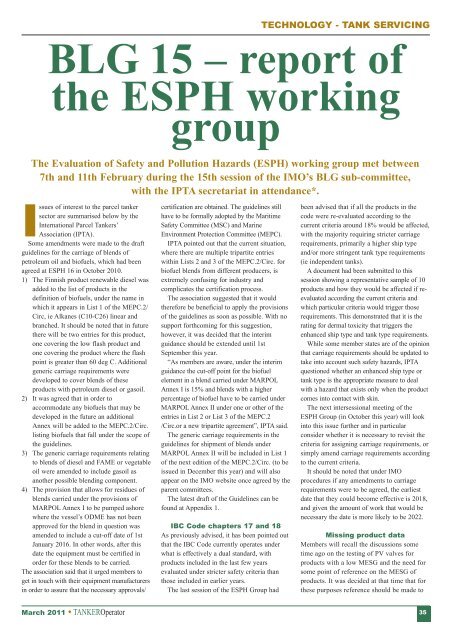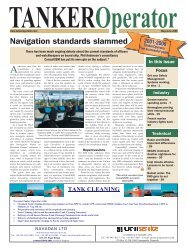The TA KEROperator - Tanker Operator
The TA KEROperator - Tanker Operator
The TA KEROperator - Tanker Operator
You also want an ePaper? Increase the reach of your titles
YUMPU automatically turns print PDFs into web optimized ePapers that Google loves.
TECHNOLOGY - <strong>TA</strong>NK SERVICING<br />
BLG 15 – report of<br />
the ESPH working<br />
group<br />
<strong>The</strong> Evaluation of Safety and Pollution Hazards (ESPH) working group met between<br />
7th and 11th February during the 15th session of the IMO’s BLG sub-committee,<br />
with the IP<strong>TA</strong> secretariat in attendance*.<br />
Issues of interest to the parcel tanker<br />
sector are summarised below by the<br />
International Parcel <strong>Tanker</strong>s’<br />
Association (IP<strong>TA</strong>).<br />
Some amendments were made to the draft<br />
guidelines for the carriage of blends of<br />
petroleum oil and biofuels, which had been<br />
agreed at ESPH 16 in October 2010.<br />
1) <strong>The</strong> Finnish product renewable diesel was<br />
added to the list of products in the<br />
definition of biofuels, under the name in<br />
which it appears in List 1 of the MEPC.2/<br />
Circ, ie Alkanes (C10-C26) linear and<br />
branched. It should be noted that in future<br />
there will be two entries for this product,<br />
one covering the low flash product and<br />
one covering the product where the flash<br />
point is greater than 60 deg C. Additional<br />
generic carriage requirements were<br />
developed to cover blends of these<br />
products with petroleum diesel or gasoil.<br />
2) It was agreed that in order to<br />
accommodate any biofuels that may be<br />
developed in the future an additional<br />
Annex will be added to the MEPC.2/Circ.<br />
listing biofuels that fall under the scope of<br />
the guidelines.<br />
3) <strong>The</strong> generic carriage requirements relating<br />
to blends of diesel and FAME or vegetable<br />
oil were amended to include gasoil as<br />
another possible blending component.<br />
4) <strong>The</strong> provision that allows for residues of<br />
blends carried under the provisions of<br />
MARPOL Annex I to be pumped ashore<br />
where the vessel’s ODME has not been<br />
approved for the blend in question was<br />
amended to include a cut-off date of 1st<br />
January 2016. In other words, after this<br />
date the equipment must be certified in<br />
order for these blends to be carried.<br />
<strong>The</strong> association said that it urged members to<br />
get in touch with their equipment manufacturers<br />
in order to assure that the necessary approvals/<br />
certification are obtained. <strong>The</strong> guidelines still<br />
have to be formally adopted by the Maritime<br />
Safety Committee (MSC) and Marine<br />
Environment Protection Committee (MEPC).<br />
IP<strong>TA</strong> pointed out that the current situation,<br />
where there are multiple tripartite entries<br />
within Lists 2 and 3 of the MEPC.2/Circ. for<br />
biofuel blends from different producers, is<br />
extremely confusing for industry and<br />
complicates the certification process.<br />
<strong>The</strong> association suggested that it would<br />
therefore be beneficial to apply the provisions<br />
of the guidelines as soon as possible. With no<br />
support forthcoming for this suggestion,<br />
however, it was decided that the interim<br />
guidance should be extended until 1st<br />
September this year.<br />
“As members are aware, under the interim<br />
guidance the cut-off point for the biofuel<br />
element in a blend carried under MARPOL<br />
Annex I is 15% and blends with a higher<br />
percentage of biofuel have to be carried under<br />
MARPOL Annex II under one or other of the<br />
entries in List 2 or List 3 of the MEPC.2<br />
/Circ.or a new tripartite agreement”, IP<strong>TA</strong> said.<br />
<strong>The</strong> generic carriage requirements in the<br />
guidelines for shipment of blends under<br />
MARPOL Annex II will be included in List 1<br />
of the next edition of the MEPC.2/Circ. (to be<br />
issued in December this year) and will also<br />
appear on the IMO website once agreed by the<br />
parent committees.<br />
<strong>The</strong> latest draft of the Guidelines can be<br />
found at Appendix 1.<br />
IBC Code chapters 17 and 18<br />
As previously advised, it has been pointed out<br />
that the IBC Code currently operates under<br />
what is effectively a dual standard, with<br />
products included in the last few years<br />
evaluated under stricter safety criteria than<br />
those included in earlier years.<br />
<strong>The</strong> last session of the ESPH Group had<br />
been advised that if all the products in the<br />
code were re-evaluated according to the<br />
current criteria around 18% would be affected,<br />
with the majority requiring stricter carriage<br />
requirements, primarily a higher ship type<br />
and/or more stringent tank type requirements<br />
(ie independent tanks).<br />
A document had been submitted to this<br />
session showing a representative sample of 10<br />
products and how they would be affected if reevaluated<br />
according the current criteria and<br />
which particular criteria would trigger those<br />
requirements. This demonstrated that it is the<br />
rating for dermal toxicity that triggers the<br />
enhanced ship type and tank type requirements.<br />
While some member states are of the opinion<br />
that carriage requirements should be updated to<br />
take into account such safety hazards, IP<strong>TA</strong><br />
questioned whether an enhanced ship type or<br />
tank type is the appropriate measure to deal<br />
with a hazard that exists only when the product<br />
comes into contact with skin.<br />
<strong>The</strong> next intersessional meeting of the<br />
ESPH Group (in October this year) will look<br />
into this issue further and in particular<br />
consider whether it is necessary to revisit the<br />
criteria for assigning carriage requirements, or<br />
simply amend carriage requirements according<br />
to the current criteria.<br />
It should be noted that under IMO<br />
procedures if any amendments to carriage<br />
requirements were to be agreed, the earliest<br />
date that they could become effective is 2018,<br />
and given the amount of work that would be<br />
necessary the date is more likely to be 2022.<br />
Missing product data<br />
Members will recall the discussions some<br />
time ago on the testing of PV valves for<br />
products with a low MESG and the need for<br />
some point of reference on the MESG of<br />
products. It was decided at that time that for<br />
these purposes reference should be made to<br />
March 2011 <strong>TA</strong>N<strong>KER<strong>Operator</strong></strong> 35

















